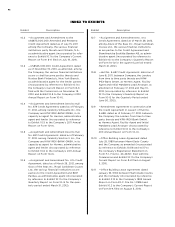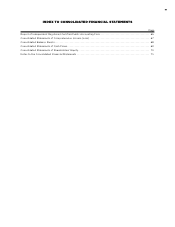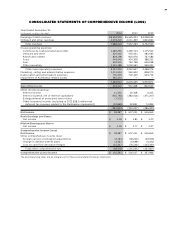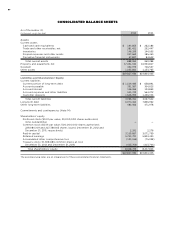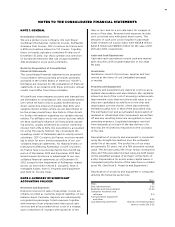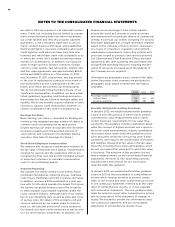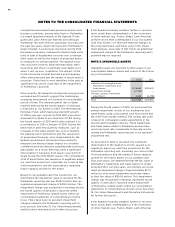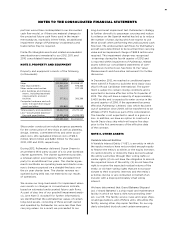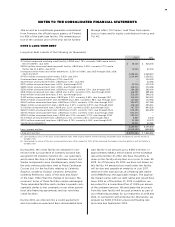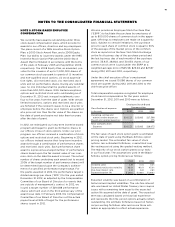Royal Caribbean Cruise Lines 2012 Annual Report Download - page 75
Download and view the complete annual report
Please find page 75 of the 2012 Royal Caribbean Cruise Lines annual report below. You can navigate through the pages in the report by either clicking on the pages listed below, or by using the keyword search tool below to find specific information within the annual report.
71
NOTES TO THE CONSOLIDATED FINANCIAL STATEMENTS
NOTE 1. GENERAL
Description of Business
We are a global cruise company. We own Royal
Caribbean International, Celebrity Cruises, Pullmantur,
Azamara Club Cruises, CDF Croisières de France and
a 50% joint venture interest in TUI Cruises. Together,
these six brands operate a combined 41 ships as of
December 31, 2012. Our ships operate on a selection
of worldwide itineraries that call on approximately
455 destinations on all seven continents.
Basis for Preparation of Consolidated
Financial Statements
The consolidated financial statements are prepared
in accordance with accounting principles generally
accepted in the United States of America (“GAAP”).
Estimates are required for the preparation of financial
statements in accordance with these principles. Actual
results could differ from these estimates.
All significant intercompany accounts and transactions
are eliminated in consolidation. We consolidate entities
over which we have control, usually evidenced by a
direct ownership interest of greater than 50%, and
variable interest entities where we are determined to
be the primary beneficiary. See Note 6. Other Assets
for further information regarding our variable interest
entities. For affiliates we do not control but over which
we have significant influence on financial and operat-
ing policies, usually evidenced by a direct ownership
interest from 20% to 50%, the investment is accounted
for using the equity method. We consolidate the
operating results of Pullmantur and its wholly-owned
subsidiary, CDF Croisières de France, on a two-month
lag to allow for more timely preparation of our con-
solidated financial statements. No material events or
transactions affecting Pullmantur or CDF Croisières
de France have occurred during the two-month lag
period of November 2012 and December 2012 that
would require disclosure or adjustment to our con-
solidated financial statements as of December 31,
2012, except for the impairment of Pullmantur related
assets, as described in Note 3. Goodwill, Note 4.
Intangible Assets, Note 5. Property and Equipment
and Note 12. Income Taxes.
NOTE 2. SUMMARY OF SIGNIFICANT
ACCOUNTING POLICIES
Revenues and Expenses
Deposits received on sales of passenger cruises are
initially recorded as customer deposit liabilities on our
balance sheet. Customer deposits are subsequently
recognized as passenger ticket revenues, together
with revenues from onboard and other goods and
services and all associated direct costs of a voyage,
upon completion of voyages with durations of ten
days or less, and on a pro-rata basis for voyages in
excess of ten days. Revenues and expenses include
port costs that vary with guest head counts. The
amounts of such port costs included in passenger
ticket revenues on a gross basis were $459.8 million,
$442.9 million and $398.0 million for the years 2012,
2011 and 2010, respectively.
Cash and Cash Equivalents
Cash and cash equivalents include cash and market-
able securities with original maturities of less than
90 days.
Inventories
Inventories consist of provisions, supplies and fuel
carried at the lower of cost (weighted-average)
or market.
Property and Equipment
Property and equipment are stated at cost less accu-
mulated depreciation and amortization. We capitalize
interest as part of the cost of acquiring certain assets.
Improvement costs that we believe add value to our
ships are capitalized as additions to the ship and
depreciated over the shorter of the improvements’
estimated useful lives or that of the associated ship.
The estimated cost and accumulated depreciation of
replaced or refurbished ship components are written
off and any resulting losses are recognized in cruise
operating expenses. Liquidated damages received
from shipyards as a result of the late delivery of a
new ship are recorded as reductions to the cost basis
of the ship.
Depreciation of property and equipment is computed
using the straight-line method over the estimated
useful life of the asset. The useful lives of our ships
are generally 30 years, net of a 15% projected residual
value. The 30-year useful life of our newly constructed
ships and 15% associated residual value are both based
on the weighted-average of all major components of
a ship. Depreciation for assets under capital leases is
computed using the shorter of the lease term or related
asset life. (See Note 5. Property and Equipment.)
Depreciation of property and equipment is computed
utilizing the following useful lives:
Years
Ships
Ship improvements –
Buildings and improvements –
Computer hardware and
software –
Transportation equipment
and other –
Leasehold improvements Shorter of remaining lease
term or useful life –



